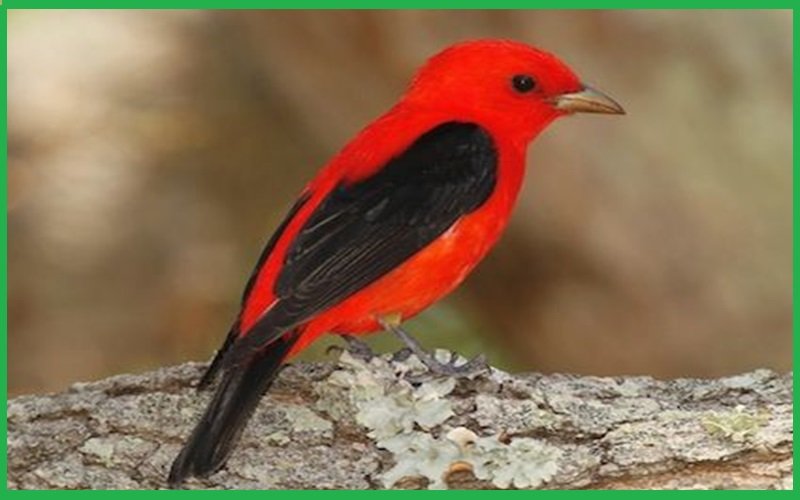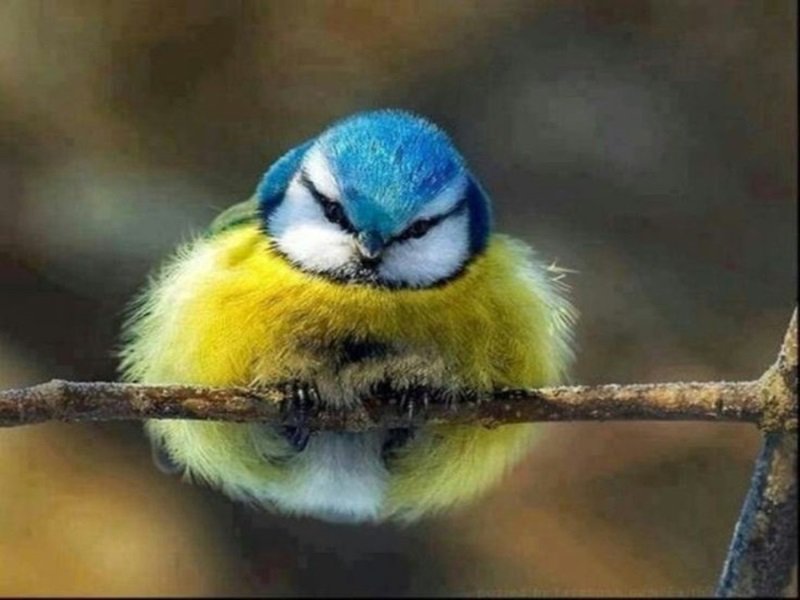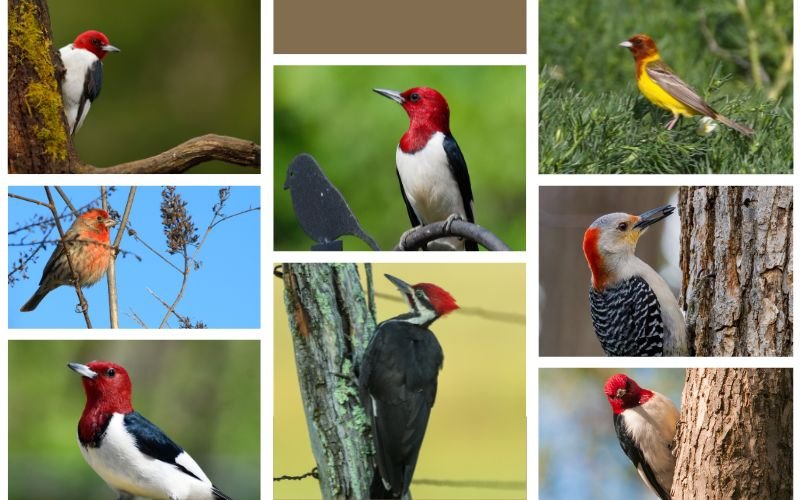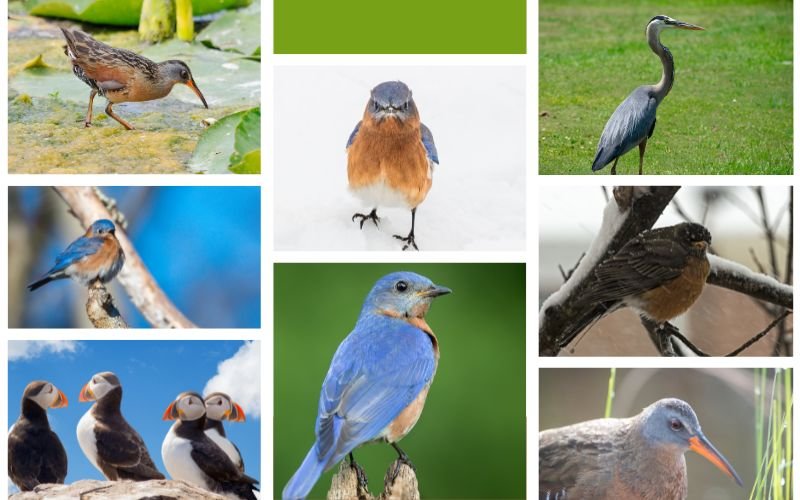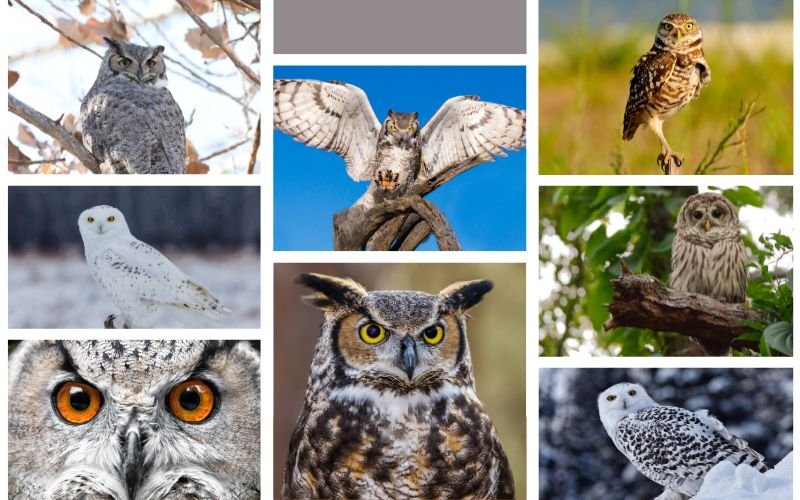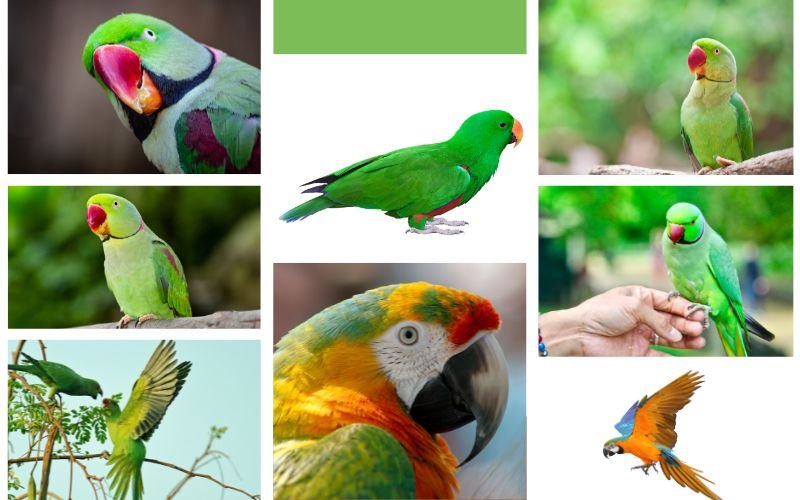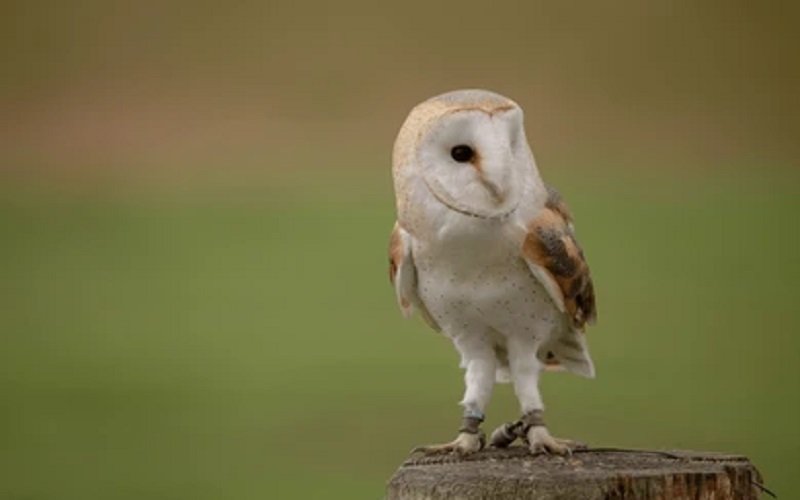Colourful birds are a treat for the eyes, but different types of black birds have a quiet elegance, making them stand out even among other birds. Some cultures may consider them to bring bad luck, but their charm is irresistible. There is no denying that birds have unique characteristics that add to beauty and create a strong foundation for the bird kingdom.
It takes great skill to distinguish between the different blackbirds. While some say that ravens and crows look the same, bird lovers will find many differences upon closer inspection.
These differences in their characteristics and features give the birds a majestic aura which is almost mysterious.
20 Types of Black Bird Names with Pictures
1. Pied Currawong
Physical appearance: These black perching birds are known for their large black beaks and yellow eyes. Small patches of white can be seen under their tails.
Female Pied Currawongs are greyer than their male counterparts, while the young birds have brown shades to their feathers (Australian Museum).
Habitat: One can spot Pied Currawongs in wild habitats like forests and woodlands. It also likes to reside in the suburbs.
Distribution: This species of bird is found mainly in Australia. Pied Currawongs are common in Eastern Australia and Queensland, but the birds are noticeably absent in Tasmania.
Intelligence: One distinct feature is that the birds are highly adaptable. Even though they prefer wildlife, they can adapt to cities as well.
Vocalisations: Their cries sound like their name, ‘currawong’, and hence, the name is derived from its distinct call. They also use a deep whistle like a wolf to communicate.
Social behaviour: The Pied Currawongs have a variety of social behaviours. It may hunt solo but will also hunt in groups when needed.
Their diet includes small animals, but they will occasionally hunt for animals like possums. When building a nest, the female takes up the dominant role. When the female starts to incubate the eggs, the males hunt for food.
2. White Winged Scoter
Physical appearance: The White Winged Scoter is one of North America’s largest species of scoters. They are mostly black but have white specks on their wings, and their eye patches are also white.
The White Winged Scoters can be identified with their orange beaks, which have a black spot on them.
Their feet are of a reddish or orange colour (Ducks Unlimited). Female scoters are more of a brownish shade which is so dark that it looks black at first glance. Compared to their male counterparts, their hues are duller.
Habitat: These birds are found in regions of North America which are rich in freshwater. The White Winged Scoter can also be spotted in wetlands during breeding.
If one visits brackish waters or lakes, one may spot these dignified birds wading through. Lakes around dense islands are also hotspots to spot a White Winged Scoter.
Distribution: The White Winged Scoters are severely impacted by hunting and predators. One reason is that the scoters return to the same spots repeatedly, making them a target for hunters and poachers.
It was estimated that the population of these birds was around 675,000 in the 70s, but the current numbers may be even lower than that because there are no clear latest statistics.
Intelligence: They fly in flocks during migration. They fly at low altitudes during most seasons, but during migration seasons, they can fly quite high in the sky (Audubon).
They form long, wavering lines in the sky. When it comes to mating, the male ducks are quite aggressive, chasing the female ducks in short underwater chases to mate.
Vocalisations: When wading on water, they are usually quiet, but it is not uncommon to hear loud rushing noises when they fly.
Social behaviour: As mentioned above, a male is quite aggressive during mating season. Several may chase one female to mate with her, and the nesting acts can start late.
The female scoters incubate the eggs and tend to them when they hatch. The young birds can also feed themselves, making this species naturally self-sufficient.
3. Boat Tailed-Grackle
Physical appearance: Lanky and long, the Boat Tailed Grackle is known for its sharp beaks. This bird is smaller than a Fish Crow and is majestic. The males have silky black feathers, which makes them an alluring sight. The females are of dark brown shades with pale eyebrows and a stripe resembling a moustache (All About Birds).
Habitat: If one visits the marshlands of Florida, one might catch a glimpse of the Boat Tailed Grackle. They usually hang around water bodies, coasts, flooded areas, or mudflats (Audubon).
Distribution: The Boat Tailed-Grackle are an aquatic creature that prefers to build its nests around water. They are most commonly found around the coasts of Louisiana and sometimes even Texas. They may stray far from tidewater in Florida, but in other regions, they are mostly found in their natural habitats.
Intelligence: The Boat-Tailed Grackles are quite smart and cunning when it comes to hunting. They loiter around the water bodies, swiftly waiting to catch food in their beaks.
Their diet consists mostly of water-based animals like insects, shrimps, frogs, tadpoles etc. However, they also break into Heron’s nests when the parent birds are away. They then proceed to feed on the eggs.
Vocalisations: The Boat Tailed Grackle nests in noisy areas, and the males make loud noises when fluttering their wings and letting out loud, shrilling cries.
Social behaviour: This species is known for its promiscuity. During mating season, the males spread their feathers and make rattling cries. Several males may do this together and are quite territorial about their areas. They nest in colonies around sawgrass or bulrushes.
The female birds are in charge of incubating and feeding the eggs, so the males take a less prominent role in raising the hatchlings.
4. European Starling
Physical appearance: The European Starling is known for its triangular wings and stocky frame. Another unique feature is that they have white spots in the winter, but their appearance becomes darker by summertime, and their feathers turn silky (All About Birds).
Habitat: The European Starlings are urban dwellers. They prefer noisy places like large cities, parks, farms etc. They have no scruples to inhabit any place with a large population, so it is not unusual to find their nests stuffed in buildings.
Distribution: Interestingly, this bird was first brought to the US by Europeans in 1890, and their expansion was at a speedy rate. They are common across the US and found almost everywhere (Audubon).
Intelligence: The first word which comes to mind when describing these birds is pesky. They are known to disturb habitats where humans live and can be aggressive.
However, they are quite intelligent creatures and can mimic the cries of other bird species. They are also notable for being able to distinguish between tastes because they cannot digest a sugar substance called sucrose.
Vocalisations: One European Starling can copy up to 20 cries of other species. Their usual cries are like wheezes and sputters.
Social behaviour: The males are the ones who build nests and establish their dominance in a territory. They attract females by perching on their nests and singing to attract a nearby female flying by.
They mostly fly in flocks when hunting and use their beaks to search for food in the ground. Both the parents incubate the eggs and also feed the baby birds. In many cases, the males may have more than one mate.
Also, a female Starling may hatch her eggs in another female’s nest. This happens when a female Starling is late to the breeding season and cannot find a mate early on, which leads them to lay their eggs in another’s nest.
5. Rook
Physical appearance: The Rook is known for its unique beak, which is the shape of a cone (BTO).
Habitat: They are mainly found in Europe, especially Britain and Ireland. They favour villages and pastures the most, preferring to flock around the open countryside with lowlands.
Distribution: The Rooks are rarely seen in places like London but can be spotted more frequently in the lowlands of Ireland and Britain. They mostly reside in Ireland, which is rich in lowlands.
There have been very few changes in their distribution, and they are abundant in their natural habitats.
Intelligence: According to studies conducted in the UK, Rooks are quite intelligent birds. They can solve complex puzzles through teamwork, and many labs study their behaviour to get insights into the bird kingdom (BTO).
Vocalisations: Their cries are similar to a crow’s, occasionally making gurgling and raucous noises.
Social behaviour: Rooks are social creatures and nest in colonies. One tree may have numerous nests of Rooks. They mate for life but are not always faithful to each other (Bird Fact).
6. American Crow
Physical appearance: One of the most common kinds of crows, the American Crow is known for its full black feathers.
Habitat: There is no place where one cannot spot them! Even though there have been attempts to eradicate them, American Crows are quite the survivors (Audubon). They are abundant across almost all habitats, whether in cities or suburbs.
Distribution: They are mostly found in woodlands, farms, fields, towns, or open spaces. Their appearances in various places are quite common, but they rarely feed from the food put out in backyards. They are highly adaptable to their surroundings.
Intelligence: American Crows are among one of the most intelligent birds. They are sociable when not nesting and like to fly in communities. Sometimes, a crow may leave their home flocks to fly with others around open spaces to find food.
They are also cunning, which is handy because they are not scavengers. Hence, they might follow other birds to find their nests and steal food from there (All About Birds).
Vocalisations: The American Crow is known for its distinct caw, which makes it easily identifiable.
Social behaviour: They fly in flocks, especially during winter. Large flocks of crows are known to create a nuisance in humans’ habitats, often their cries disturbing people.
7. Pelagic Cormorant
Physical appearance: Small, slender birds have silky black feathers with purple highlights (All About Birds). Their necks resemble the shape of a broomstick and have coral patches on them.
Habitat: They prefer coastal bays with soothing sounds. Avid bird watchers may also spot them in rocky areas near water bodies.
Distribution: They are mostly found around the Pacific coastlines, often perched together in flocks. In the 1980s, around 120,000 Pelagic Cormorants were estimated in the US. To spot these perky birds, bird lovers might consider taking a trip to the coasts and hope to spot one!
Intelligence: They are quite predictable, breeding in the same spots to find food. Their favourite hunting method is diving underwater; they are known to hold their breath for up to 3 minutes to grab fish. Compared to other kinds of cormorants, they are quite shy.
Vocalisations: They are shy and stay quiet most of the time, but the males can make groans or gurgling sounds. Females mainly click their beaks.
Social behaviour: These birds are hard to spot because of their shy nature. They nest in colonies and build nests in desolate or inaccessible areas. The Pelagic Cormorant cannot defend their nests well, so their nests are usually out of sight (Audubon)
8. Anhinga
Physical appearance: Anhingas have a peculiar tail resembling that of a Turkey. They are slim and have long S-shaped necks. Their beaks are shaped like daggers, and the birds look flat when flying high in the sky (All About Birds). Thin silver strips can be seen on the backs of the male Anhingas, while the females have tan heads.
Habitat: They prefer quiet places with calm waters.
Distribution: They live on shallow waters with long branches or trees to hide them. Nature lovers may not spot them on open waters because they mostly roam around bays and lagoons.
Intelligence: It is shy and likes to stay away from sight. They also feed alone, making the bird highly unlikely to be spotted (Audubon).
They swim underwater for fish but need to be faster. Instead, they wait until they spot a fish swimming towards them before grabbing it with a swift movement of its neck. This implies that the birds are quite adept at hunting.
Vocalisations: They are usually silent but make clicking sounds when they are in colonies.
Social behaviour: Since the birds are shy, they nest in solitary places. The males perch on the colonies and display their territory to passing females to mate. They may even take over the nests of Herons.
9. Double-Crested Cormorant
Physical appearance: The Double-Crested Cormorants are dark bodies with thin necks and beaks. Their beaks are shaped like a hook and can slit low towards the water (All About Birds).
Habitat: The Double-Crested Cormorants are visible to bird watchers around the coastal areas and lakes. They seek out aquatic animals for food and can be spotted by bird lovers around those areas.
Distribution: They are predominantly in North America, especially around freshwater bodies. Some may even breed along the coasts or large inland lakes.
Intelligence: They forage in muddy waters or shallow water to look for food. They float on the surfaces to hunt and dive when they spot a fish. In flight, they fly in a V-shape in a flock.
Vocalisations: They can make deep grunts similar to a pig’s oinks.
Social behaviour: They nest in colonies. These colonies may also contain breeds like Wading Birds, indicating that the Double Crested Cormorants are okay with living in mixed settings. It attracts mates by splashing its wings on the water and dodging through it to find weeds to give the females.
10. Common Black Hawk
Physical appearance: This blackbird has large, broad wings and is quite chubby. They have long legs and short tails.
Habitat: Their favourite habitat is around streams and water. The Common Black Hawk prefers to stay away from humans and lives in tropical places (All About Birds).
Distribution: They are found mostly in Mexico but are rare in the US. They can be found in solitary places with permanent water and rainforests in the US.
Intelligence: They are quite creative when it comes to hunting for food. They scavenge the shallow waters and perch nearby. When they spot a fish, they use their large wings to fly close and startle them. They chase their prey to the water’s shallower parts and snatch them instantly (Audubon).
Vocalisations: They do not usually call out, but if they spot any predators or humans, they let out an alarm-like cry.
Social behaviour: They are solitary birds who dislike being disturbed by humans. When calling out during the mating season, they fly high and soar with their feet dangling. They then cry out to attract the females.
11. Common Raven
Physical appearance: The Common Raven is among the largest songbirds, almost like the size of a hawk.
Habitat: They prefer to live near mountains, coastal cliffs, and deserts. However, they can live in a wide area of places (Audubon).
Distribution: Since they are adaptable, they can live in extremely cold areas like the Arctic Circle and hot regions. They predominantly live in the Northern Hemisphere (All About Birds).
Intelligence: The Common Raven is among the smartest species of birds and hence, are dangerous hunters. They may work in pairs to raid bird colonies.
One of the birds distracts the birds while the other one snatches the eggs. Moreover, studies have found that Common Ravens rush to the spot when they hear sounds like gunshots to look for corpses while the other birds flee in fright.
Vocalisations: They are known to mimic the cries of other animals and can even copy human voices.
Social behaviour: The Common Ravens are extremely defensive and territorial. They will not hesitate to drive their kind away from an area to establish dominance. However, they will also gang up in numbers to feast on carcasses to send threats to other animals.
You can read this post to know more about this bird and other blue and black birds.
12. Rhinoceros Hornbill
Physical appearance: Despite being mostly black, they are known to have a variety of colours in their appearance. Their legs, vent, and tail are white. They have a bill which is in red and orange colours. Males have red eyes circled with black rims, while females have white rims (Animalia).
Habitat: They are found mostly in lowlands and tropical forests.
Distribution: The Rhinoceros Hornbill is found in Asia, namely Brunei, Thailand, Indonesia, and Malaysia.
Intelligence: The bird likes to stay in pairs and participate in various activities (Virginia Zoo). They are considered to be very intelligent by those who look after them.
Vocalisations: The Rhinoceros Hornbill has an interesting ‘gok’ quite deep. They often sing duets in pairs, albeit in different pitches (Wild Ambience).
Social behaviour: They mostly like to stay in pairs, with occasional sightings in flocks. The Rhinoceros Hornbill mates for life and are monogamous. They are also very territorial, defending their nests with loud trumpet-like calls.
13. Black Stork
Physical appearance: The Black Stork is mostly black with white underparts, a pointy beak and long red legs (Animalia).
Habitat: They are migrant birds which live in various parts of Europe.
Distribution: The Black Storks are a rare species sometimes spotted in parts of Spain and Portugal. They fly long distances during migration season, flying even to Asia. However, they tend to bypass the Mediterranean Sea and use other routes to migrate.
Intelligence: The Black Storks are shy and do not like to wander in places with humans. They stick to their kind or wander alone. It is shy and reserved, preferring to remain away from sight.
Vocalisations: Their calls sound like loud inhalation. When threatened, they let out a hissing sound. Males let out squeals as mating calls.
Social behaviour: They are solitary and rarely interact with other species. They work in pairs during nesting season, flying in parallel lines over the nests to protect them. Both parents protect the young birds of them. However, the birds also follow a ‘survival of the fittest policy because when food shortages, they often kill their weakest baby.
14. Great Cormorant
Physical appearance: With blocky heads and a white patch under their throats, the Great Cormorants are quite a sight to behold. They have large orange and white bills, which they use to hunt for food (Audubon).
Habitat: They prefer sea cliffs for nesting, but they are mostly spotted around shallow waters.
Distribution: Earlier, there were not many numbers of Great Cormorants, but the population has grown (All About Birds). They can be found breeding in North America.
Intelligence: The Great Cormorants are very intelligent and quite friendly. They are adaptable in all situations and can even be kept as pets. As pets, they are attached to their owners, showing their loyalty (Crowe).
Vocalisations: They make loud grunts or guttural sounds.
Social behaviour: The males make a nest and display it to the other females flapping their wings and showing off their white patches. Both parents feed their babies.
15. Lesser Yellow-Headed Vulture
Physical appearance: Like their names, they have a yellow head and a predominantly black body (Peregrine Fund). Their feet are grey, and contrasting shades of silver and black patterns can be seen when they fly. New bird watchers may confuse them with Turkey Vultures, but those have red heads.
Habitat: They cannot build their nests. Instead, the female birds lay eggs on thick grass or hollow trees. The Lesser Yellow Headed Vultures are known to live around wetlands, and there are concerns that they may lose their homes due to the rapid decrease in wetlands.
Distribution: The Lesser Yellow Headed Vultures are found in South America, Central America, and the Andes. They venture into brackish areas and freshwater marshes. For bird lovers who are keen to spot them, they may find the birds around the wetlands.
Intelligence: They are scavengers by nature. Like other Vultures, the Lesser Yellow Headed Vulture also feeds on carcasses, but some researchers believe these birds may kill dying fish to devour them. Moreover, they have an acute sense of smell, so they can easily sniff out dying creatures or corpses.
Vocalisations: They are silent creatures but may make occasional grunts.
Social behaviour: In most cases, the birds are seen alone but may also be spotted in pairs or groups of 10. Both parents feed the babies through regurgitating digested from their stomachs to the hatchlings.
16. Black Vulture
Physical appearance: These dapper birds are black except for some white star-shaped markings under their wings. They have short tails and broad wings, which make loud, powerful wingbeats (All About Birds).
Habitat: They are found mostly in open spaces and lowlands but avoid mountains.
Distribution: The Black Vulture is common in places like Latin America, but one will not spot them flying over open water bodies. Lowlands will be the best option for avid bird watchers to study them.
Intelligence: They may appear smaller than their cousin, the Turkey Vultures, but they are quite aggressive and intelligent. The Black Vultures are known to chase other Vultures away from carcasses.
Vocalisations: They do not have vocal abilities. The most noise they can make are grunts and groans.
Social behaviour: While mostly solitary, they can work together in flocks to drive away Turkey Vultures (Audubon). The Black Vultures do not have a good sense of smell, so they follow a Turkey Vulture, and once the latter detects food, the Black Vultures gang up to drive the Turkey Vulture away.
17. Greater Yellow-Headed Vulture
Physical appearance: They look similar to Lesser Yellow Headed Vultures but have splashes of green and purple on their feathers. They also have longer wings and look paler when flying (Oiseaux).
Habitat: They avoid open habitats and prefer to stay in thick rainforests or tropical areas (Peregrine Fund).
Distribution: The Greater Yellow-Headed Vultures live in various parts of South America, especially around the lowlands. Forest enthusiasts and nature lovers who foray into rainforests may spot them.
Intelligence: They are also scavengers with a good sense of smell. Unlike Black Vultures, they happily share meals with other predatory birds.
Moreover, they are slow eaters but also cultured. They clean up their meals by finishing all the meat and properly picking on the carcasses until there are little to no remains.
Vocalisations: These birds do not have a syrinx, so they are mostly silent other than the occasional grunts and groans.
Social behaviour: As mentioned above, they are cultured and willing to share their feast with other birds. They are shy and rarely aggressive. These birds like to be alone and are rarely seen in flocks.
18. Southern Ground Hornbill
Physical appearance: The Southern Ground Hornbill are almost the size of the turkey and are the largest species of Hornbill. They have black feathers, yellow eyes, and brightly coloured throats. Males have red throats, while females have a splash of violet on their throats (National Geographic).
Habitat: These birds prefer grasslands or savannas in dry regions.
Distribution: They live in the southern parts of Africa and are native to those regions. They live in groups of 2 to 9 members. However, the birds are threatened because their nests are being destroyed due to development projects, and climate change has also reduced their population.
Intelligence: They are omnivores which feed on seeds, fruits, and vegetation along with large mammals like hares, small monkeys, squirrels, and mice. They use their long bills to slice their food in half. They hunt in groups.
Vocalisations: The Southern Ground Hornbill is known for its loud cries, almost like a lion’s roar.
Social behaviour: The birds live in a group; however, only the dominant male and female breed. They mate for life. The male members defend the group, and both sexes care for the babies.
19. Turkey Vulture
Physical appearance: These dark, long-winged birds are larger than most raptors except eagles and condors. The Turkey Vultures appear black from a distance but are more of a dark brown shade. With a red head and pale bill, they resemble Turkeys.
Habitat: Turkey Vultures are usually spotted near roads and farms. On hot days, they can be spotted flying high up in the skies, while during winter, they are perched on trees or poles (Audubon).
Distribution: They are commonly found in open or semi-open spaces. Turkey Vultures nest in rocky areas along the North American regions.
Intelligence: They have a keen sense of smell and follow other scavengers. By following other scavenger birds, they can quickly find carcasses and feast on them.
Vocalisations: Turkey Vultures also do not have any vocals other than hissing. During the flight, they make a low, nasal sound.
Social behaviour: They fly in groups to surround carcasses. The groups can be small or big depending on the number of Turkey Vultures (All About Birds). They do not make nests but lay eggs in hollow trees or flat surfaces with thick surroundings.
20. Black Swan
Physical appearance: The Black Swans are known for their graceful black feathers and striking red beaks. When swimming in the water, they create a majestic view that enchants everyone (Australian Museum).
Habitat: The Black Swan likes to swim on salty water during the day. They can travel long distances by travelling at night.
Distribution: Black Swans are found mostly in Australia. They are also commonly sighted in New Guinea and New Zealand.
Intelligence: They are quite similar to other swans but have strong fliers. Black Swans adapt to both solitary and group existence, altering between both. Compared to other swans, they are not so territorial (Animalia).
Vocalisations: During flight, they make beautiful whistling sounds, while on water, they make high-pitched trumpet sounds.
Social behaviour: The Black Swans are monogamous, and both parents help to incubate the babies. They travel in pairs or flocks, creating a V-shape in the sky. Spotting them in their marvellous glory is a bird lover’s delight!
Conclusion
Blackbirds are one of the marvels of nature. Despite their reputation as fearsome and harbingers of bad luck, each has unique qualities which add to their magnetic personalities. Some are shy, some are friendly, and some are violent, but there is no doubt that the different varieties of blackbirds have their charm, which attracts bird lovers.




